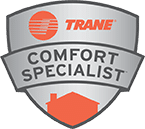Indoor air pollution is a serious problem that affects every home and building. Allergens like pollen and mold spores are always present in the air both inside and outside the home. The bigger issue is that all of your home’s building materials, cleaning products, electronic devices and even your furniture also release a huge number of pollutants, including harmful volatile organic compounds (VOCs) like formaldehyde, methylene chloride and benzene. This is why the concentration of many of these pollutants is typically anywhere from three to five times higher indoors.
The fact that indoor air is so much more polluted means that every homeowner really should take steps to try to lower the concentration of pollutants and improve their indoor air quality. If you are concerned about indoor air pollution, you may have heard that houseplants are a good way to remove pollutants and improve air quality. Today, we’re going to look at what science says about houseplants and air quality and also what other options you have for minimizing indoor air pollution.
House Plants and Air Quality
There has long been a lot of debate as to the effects of houseplants on indoor air quality. Numerous studies have shown that some species of plants do capture and remove formaldehyde, benzene and other VOCs. The only real question is how effective plants are at improving air quality.
Unfortunately, most recent studies have shown that houseplants aren’t all that effective at improving air quality even if they will still remove some VOCs from the air. A study performed by NASA in the late 80s did show that some plant species removed anywhere from 10% to 70% of all VOCs from the air. The only issue is that this study was performed in a small, completely enclosed chamber as NASA was mainly looking to see what impact houseplants could have on air quality for future space missions.
More recent studies have repeatedly shown that the NASA study simply doesn’t translate to actual real-world conditions. In fact, one study showed that the average home would need to have nearly 700 plants to remove anywhere near the same effect as the plants did in the NASA study. Having 700 plants in your home isn’t feasible, and there are far better ways to improve your home’s air quality. This isn’t to say that plants won’t have some effect, but they definitely won’t overcome your home’s air quality issues.
Why Air Purifiers Are the Best Choice for Improving Indoor Air Quality
Another more recent study measured the amount of VOCs that different plants could remove from an open space in one hour, and this study concluded that even the most effective plants removed less than 1% of the amount of VOCs from the air as an air purifier would. This means that if you are really looking to improve your home’s air quality, a whole-home air purification or filtration system is definitely the way to go.
There are a wide variety of different whole-home air purification and filtration systems on the market, all of which are far more effective than a basic HVAC air filter at removing VOCs and other airborne allergens and pollutants.
The most basic type is a media filter, which is essentially a larger, more effective version of an HVAC air filter. This type of filter is installed in the ductwork. Whenever your heating or air conditioning is running, the HVAC blower pulls air through the filter which traps the majority of airborne particles.
Another option is an electrostatic filter or electronic air cleaner. This type of filter releases charged ions that stick to most airborne particles as they pass through the air cleaner. At the end of the unit is a special filter that is oppositely charged. Since positive and negative particles attract, all of the charged particles are attracted and stick to the filter. An electronic air cleaner will remove the majority of airborne allergens and pollutants, but these units typically don’t have much of an effect on lessening the concentration of VOCs. That being said, they can still make a huge improvement in your home’s air quality.
An even more effective option is to have a whole-home HEPA filtration system installed. Instead of being installed directly in the ductwork, these systems are installed as a bypass that connects to the existing ductwork. Some of the air that flows through the duct is constantly forced into the system and through the HEPA filter, which works to remove more than 99% of all airborne particles including VOCs. An internal fan in the system then pushes the clean air back into the duct, where the blower then circulates it throughout the home.
Whole-home air purification systems are even more effective as they clean the air in the entire building and not just the air that flows through the ductwork. These systems are also installed in the duct system, and they work by releasing negatively charged ions. Specifically, most systems use a process that produces gaseous hydrogen peroxide ions that are completely safe.
These negative ions are released into the ductwork, and the blower pumps the ions out into the rest of the building. VOCs and most other airborne pollutants and allergens are all positively charged, which means that they are attracted to all of the negative ions produced by the purification system. When the ions come into contact with organic molecules like mold spores, bacteria and viruses, the ions damage the molecule’s cell wall and change its DNA so that the molecules are harmless and can’t spread or reproduce.
VOCs and other pollutants are also attracted and stick to all of the negative ions in the air. When the airborne particles stick to the negative ions, both the weight and size of the particles increase. This makes the particles large enough that even a basic HVAC air filter can now trap them and remove them from the air.
Increasing the weight of the particles also makes them heavy enough that almost all of the pollutants fall out of the air and settle down onto your countertops, floors and other surfaces. As a result, you won’t have to worry about breathing all of the pollutants in since they will no longer be in the air. Wiping down your counters and mopping or vacuuming your floors will then remove all of the particles.
This type of whole-home air purification system is by far the best option for improving your home’s air quality. All of the other types only clean the air that travels through the ductwork and only work when your HVAC system is running. By circulating the negative ions throughout the entire home, a whole-home air purification system will remove almost all pollutants from the whole building. Another advantage is the process continues to work even after the unit shuts off since all of the negative ions will still be present in the air.
Expert Indoor Air Quality Solutions
Air Authority, A Riteway Service Company is your local indoor air quality expert, and we install a variety of IAQ solutions including media filters, electronic air cleaners and whole-home air purification systems. We serve both residential and commercial customers in San Antonio and the surrounding areas, and our team can also take care of all of your other HVAC needs. For more information on our IAQ services, give us a call today.





